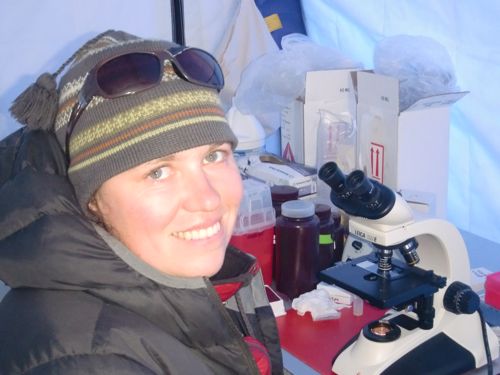The Microverse
There are microbes everywhere, and most of the time, we think nothing of them. They live all around us, on us, and inside us. They also make up the communities at the bottom of Lake Joyce. Megan and Anne are the microbiologists on our team, and their passion for studying these organisms is inspiring!
Some of these microorganisms are autotrophs, which means that they make their own food through photosynthesis. The autotrophs are dominated by cyanobacteria -- bacterial cells that contain chlorophyll. Others are heterotrophs who consume food in order to get energy. Megan and Anne study them to understand the roles each of these types play in the community. How important are the cyanobacteria as compared to the heterotroph cells? Who does which jobs to serve the community? Who is providing which ecosystem service? What genes seem to be the most in demand?
 Leptolymbia, a microorganism commonly found in the microbial mats.
Leptolymbia, a microorganism commonly found in the microbial mats.
They answer these questions using a couple of different techniques. For instance, Anne spent quite a lot of time with the microscope, tallying how many of each species were present in the samples. Additionally, Megan showed me how to use finger-sized falcon tubes to contain small samples. Into the tubes, she'd place a chemical that breaks open the cell membrane and preserves the DNA. Then, when the sample is returned to U.C. Davis, DNA analysis can reveal the species and genes present and their relative abundances.
 Anne Jungblut counting different species under the microscope.
Anne Jungblut counting different species under the microscope.
Not surprisingly, the ratios of microorganisms are different depending on whether the mat is flat or pinnacled. The ratios also vary from lake to lake, and different lakes have different colored mats as a result of which species are present, and what pigments they make. But what does that mean? Is it due to competition between species? Or is it due to available nutrients and chemicals? Or the amount of sedimentation? These questions are what bring geologists and microbiologists together and make for very rich collaborations.
These questions represent an exciting and relatively new field of study for microbiologists, too. Historically, we've only been able to culture or grow 1% of bacterial types and that allowed us to understand that 1% fairly well. However, with recent advancements in DNA analysis that make it cheaper and easier, we can understand so much more about "the Microverse".


Comments